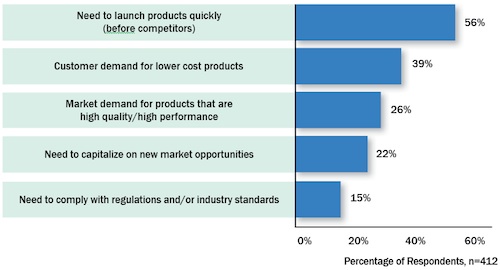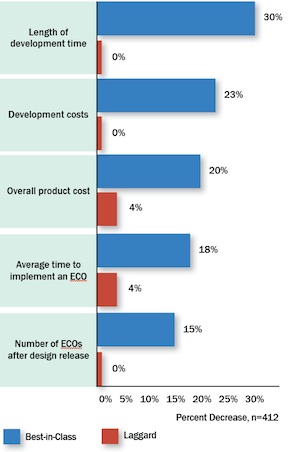June 1, 2012
By Michelle Boucher
Growing complexity, combined with pressures to get competitive products to market more quickly, is prompting organizations to take a closer look at how work is done in CAD. Advanced CAD capabilities frequently help reduce mundane tasks and increase agility in the design process.
To this end, “Top CAD Tips for Designing Today’s Complex Products: What Are the Right Tools for the Job,” a new study from the Aberdeen Group, reveals that the need to improve engineering productivity is a top factor driving organizations to evaluate their CAD solutions. In some cases, this means making a change to their primary CAD tool.
Aberdeen’s research indicates that taking advantage of the right CAD technology results in improved design efficiency—including, on average, a 14% reduction in development time since implementing their current CAD environment. The most successful achieve about twice that improvement. However, organizations that do decide to switch CAD vendors and blindly pursue change for change’s sake without taking the time to adequately support their CAD tool, risk seeing marginal, if any, improvement.
Pressures and Obstacles Drive Change
As the economy continues its slow recovery, the new products companies develop are critical to growing profitably. Releasing products that successfully capitalize on available market opportunities requires a nimble and responsive design process. In this vein, Aberdeen’s research identifies a need to launch products ahead of competitors while meeting demand for low-cost, high-performance products as the top factors currently driving organizations to improve their design processes. (See figure 1.)

Figure 1: Top 5 Pressures for Design Process Improvements
A requirement of the design process is the delicate dance of balancing conflicting customer demands with the constraints of a competitive release schedule. Attaining this balance requires a streamlined workflow—and the flexibility to quickly evaluate different design alternatives to make cost and quality trade-off decisions. While difficult enough on its own, a host of design challenges affect organizations’ ability to achieve this balance.
The organizations participating in Aberdeen’s study reported their top design challenges. The central theme emerging from their answers indicates the critical obstacles created by changing design requirements and a lack of engineering resources.
The top challenge, reported by 39% of study participants, is frequent design changes. Invariably, designs will be changed as a result of shifts in product requirements (reported by 34% of respondents). However, engineering change orders (ECOs) can also result from poor insight into how parts or assemblies interact, or problems with the manufacturability of the product. Frequent changes to design requirements and ECOs impede the design process as engineers abandon new work and search for ways to fix existing designs or accommodate new needs. The later these changes occur in the design process, the more difficult and taxing it can be to address these needs (reported by 19% of respondents).
The next two challenges further limit the ability to execute on product objectives:
1. Insufficient engineering resources: Workforce reductions, staff departure, and a short crop of new engineering talent have resulted in thin engineering staff resources (cited by 29% of respondents).
2. Increased complexity: Product complexity has expanded in all sectors (25% of respondents). Assemblies have become larger and include a greater number of components. Similarly, many companies have expanded the number of configurations involved in any product line.
The combination of these two challenges puts considerable pressure on engineers to maintain high levels of productivity—while simultaneously tackling more difficult design work.
This is where CAD, particularly the advanced features that have been released by vendors in recent years, can provide much needed support.
CAD to the Rescue
Figure 2: Design Process Improvements of the Best-in-Class and Laggards |
Companies should look at the latest advancements in CAD to help manage design complexity, as well as modeling technologies that offer the flexibility to efficiently make changes to the CAD model. Technologies that also make it easier to reuse CAD models will save time and put less strain on limited engineering resources. Even improved functionality, such as embedded configuration rules that automate the creation of standard features, can make a significant impact on the speed and efficacy of product development by removing redundant work and unnecessary rework from the design process.
In addition, synchronization of model data across distributed locations improves collaboration and makes it easier to take advantage of distributed resources to further improve efficiency. As a result, organizations that successfully employ this functionality are better prepared to take advantage of market opportunities.
For some organizations, taking advantage of the latest CAD developments focused on improving productivity may require a change in an organization’s primary CAD solution. The most frequent reason companies make a switch in their CAD tools is access to new functionality. Following shortly behind, participants indicated that they changed tools to improve design productivity (44%). Other top concerns include the migration to a 3D application, ease of use of the solution, and software quality.
Improvements Reap Rewards
Investments in CAD consistently return significant benefits to the design efficiency. Study participants reported an average reduction in development time of 14% since their most recent CAD implementation. They further reported 11% reductions in development cost and overall development costs. Since their most recent CAD implementations, these organizations have reduced ECOs by 8%—and the time required to execute an ECO by 9%.
Of course, this does not mean that organizations can simply swap in new CAD and expect dramatic changes to their design process. The poorest-performing organizations (“Laggards”) isolated by Aberdeen saw no change in development time or development cost after their last CAD implementation. (See figure 2.) These organizations did see some improvement in product costs and the time required to execute ECOs (4% reduction in both), but this is less than half the average improvement experienced by all organizations. While this is marginal improvement, the loss suffered on the implementation makes it difficult to justify further expansions in an organization’s toolset.
By contrast, organizations that see the most benefit from their CAD tools take advantage of the right support processes and capabilities. Top performers (“Best-in-Class”) report exceptional improvements that reach well beyond the average. These organizations have reduced development time by 30%, product costs by 20%, development costs by 23%, ECOs by 15%, and the time required to execute ECOs by 18%. This is roughly twice the improvement experienced by all participants.
Key Takeaways
For many organizations, a change in CAD tools will permit access to new functionality that has a significant impact on engineering productivity. Organizations that implement and support the CAD capabilities that best support their design processes can expect to see performance improvements on par with the Best-in-Class. Organizations that fail to take advantage of these tools effectively are less likely to see real change in their processes.
It is imperative to assess your own needs and identify the CAD functionality that best supports them. Organizations that implement the functionality that best provides for the needs of their design processes will see more substantial improvements. Aberdeen Group’s “Top CAD Tips for Designing Today’s Complex Products: What Are the Right Tools for the Job” report provides further information about how organizations are using CAD to improve their design processes, including the CAD capabilities the Best-in-Class use that their competitors overlook.
By implementing the CAD functionality and process changes deployed by the Best-in-Class, organizations will be able to recover the time and cost they lose to redundant and avoidable tasks. Organizations that effectively incorporate these CAD capabilities into their design processes gain tangible competitive advantages resulting from improved design process flexibility and designer productivity. Those that don’t needlessly expend resources on software investments that leave design performance functionally unchanged.
The full Aberdeen study is available at no cost until June 30, 2012.
Michelle Boucher is a research analyst in the Product Innovation and Engineering practice at Aberdeen Group, where she focuses on identifying product development best practices. Send e-mail about this article to [email protected].
MORE INFO
Subscribe to our FREE magazine, FREE email newsletters or both!
About the Author
DE’s editors contribute news and new product announcements to Digital Engineering.
Press releases may be sent to them via [email protected].







